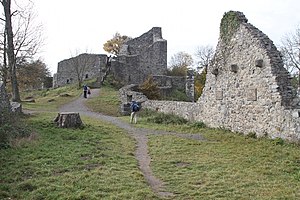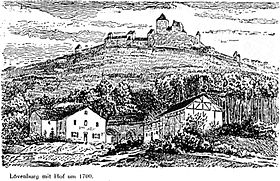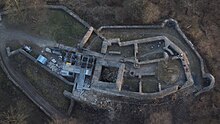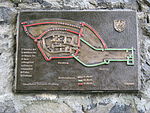Löwenburg (Bad Honnef)
| Löwenburg | ||
|---|---|---|
|
Ruin of the Löwenburg |
||
| Alternative name (s): | castrum Lewinberg | |
| Creation time : | 1247 | |
| Castle type : | Höhenburg, summit location | |
| Conservation status: | ruin | |
| Standing position : | Count | |
| Place: | Bad Honnef | |
| Geographical location | 50 ° 39 '50.3 " N , 7 ° 15' 1" E | |
| Height: | 455 m above sea level NHN | |
|
|
||
The Löwenburg is the ruin of a medieval hilltop castle on the 455 m high mountain of the same name in the Siebengebirge . It belongs to the urban area of Bad Honnef in the North Rhine-Westphalian Rhein-Sieg district . Due to the exposed location of the ruin with a view of the Rhine Valley near Bonn and the front Westerwald , it is one of the most popular hiking destinations in the Siebengebirge. The ruin is a ground monument under monument protection .
topography
The castle ruin Löwenburg is located on an east-west running plateau, at least partially artificially created in the Middle Ages, on the summit of the Löwenburgberg, a weathered volcanic vent made of nepheline latite . The main castle is on the highest part of the summit at the western end of the plateau. The outer bailey extends on the lower plateau area west of the main castle.
A steep, ring-shaped path leads to the castle. In places, an overgrown older ravine can be seen in the area, which marks the original course. Below the outer ring wall, at a less steep point on the south-west side of the castle hill, a moat forms a first fortification obstacle.
When the neck ditch was built, part of the building material for the castle was also obtained. The breaking point of the latit can still be seen in the terrain. Most of the walls are made of rough quarry stones from the latite that is found here. Individual special components, for example the jamb of the Palas were from non-local trachyte and tuffs made.
The oldest known, pictorial representation of the castle ruins comes from an etching by Wenceslaus Hollar based on a watercolor pen drawing from 1629.
history
The Löwenburg was built in the second half of the 12th century by Heinrich II , Count von Sayn , who had advanced from the Westerwald , as a border fortress against the castles of Drachenfels and Wolkenburg in Cologne . It was first mentioned in a document on August 29, 1247 as castrum Lewinberg during the division of the Saynian inheritance by Countess Mechthild von Sayn , who reserved the right to live in the castle. The main castle, bailey and the northern outer bering built in the 13th century. As a result of the succession , the castle passed to the nephews of Mechthilds, a line of the Counts of Sponheim-Heinsberg , who immediately referred to themselves as Lords of Löwenburg . The main place of their rule was Honnef .
As a result of numerous changes of ownership, the castle fell to the Duchy of Jülich-Berg in 1484 . The Löwenburg office was administered from the castle until the middle of the 16th century.
The war campaigns at the end of the 16th century, from which the Löwenburg office suffered particularly, turned it into ruins. From then on, the elongated hilltop castle complex of the 13th century with its stronghold, kennel and outer bailey became increasingly dilapidated. The cistern in the courtyard and two side walls of the former keep of the stronghold with the basic dimensions of ten by ten meters have been preserved. The keep itself was partially demolished in 1832 - and completely in 1881 - due to its disrepair, after an initiative to maintain and restore the ruins had previously failed. In 1834 security and restoration measures were carried out on the tower ruins.
In 1861, a forerunner of today's State Forestry Office in Siegburg , the Royal Prussian Oberförsterei Siebengebirge, took over the administration of the ruins. In 1862 individual restoration work was carried out and in the years 1897–1901 a backup of the majority of what was already there was carried out. In July 1906 a lookout tower was built at the highest point of the castle. In 1908 the first excavations were carried out on the Löwenburg in order to uncover parts of the castle. At the beginning of the Second World War , an observation post was set up in the upper castle for the air defense in 1939 . During the fighting for the American troops to cross the Rhine, the Löwenburg came under heavy fire, which the observation tower built in 1906 probably also did not withstand.
With the dissolution of the state of Prussia in 1947, the Löwenburg became the property of the state of North Rhine-Westphalia . In 1951, the castle ruins were largely dilapidated and overgrown, and the ascent to the summit via most of the footpaths was very difficult. In order to increase the heavily reduced tourist value of the Löwenburg again, the Beautification Association for the Siebengebirge planned in 1951 to open the road from the Schmelztalstraße via the Einsiedeltal to the castle ruins for motor vehicle traffic. Today there is a road from Margarethenhöhe that is not open to the public . In 1961 the first aerial photo of the Löwenburg was probably taken.
From 1979 to 1985, the State Forestry Administration carried out extensive safety and restoration work with the help of the Bonn State Building Authority . The still existing foundation walls of the castle complex were exposed and secured. The Rheinisches Landesmuseum accompanied the excavations . The restored castle complex was inaugurated on October 2nd, 1985. Several bronze plaques on the mountain summit created by the Königswinter sculptor Sigrid Wenzel from 1988 and 1989 show the original appearance of the castle. After new damage occurred to the keep in the winter of 2012/2013, extensive renovation measures were carried out on the keep's masonry in 2013. On the occasion of the renovation, the Cologne District Government initiated new archaeological excavations in the interior of the tower and in the area of the Zwinger south of it in spring 2013. During the excavations, around a dozen vessels of Siegburg stoneware were recovered, which are exhibited in the nature park house of the Beautification Association for the Siebengebirge. In the course of the archaeological investigation in 2013, the entire castle ruin was measured for the first time with exact tachymetry and photogrammetry .
literature
- b + s Bau Königswinter (ed.): The Löwenburg in the Siebengebirge. Festschrift on the occasion of the completion of the conservation work. Bonn 1985.
- Wilhelm Bier, Werner Osterbrink (ed.); Wilhelm W. Hamacher : The Löwenburg: Pictures and data on the history of the castle and its lords. Edition Wolkenburg. Rheinbreitbach 2004. ISBN 3-934676-16-2 .
- Winfried Biesing: On the history of the Löwenburg and its masters. In: Heimatverein Siebengebirge eV (ed.): Streiflichter from the Siebengebirge. Königswinter 1986, pp. 197-223.
- Manfred Groß, Hans Lohmann: The archaeological investigations on the Löwenburg, town Bad Honnef, Rhein-Sieg-Kreis. In: Excavations in the Rhineland ̓79 / 80. Cologne 1981. pp. 193-200.
- Helga Hemgesberg: The Lords of Löwenberg. Studies on the local history of the city of Bad Honnef, issue 6. Bad Honnef 1988.
- Dirk Herdemerten, Björn Zängle, Uwe Schoenfelder: High above Bad Honnef. New investigations at the Löwenburg ruins. Archeology in the Rhineland 2014. Darmstadt 2015. P. 182–184.
- Heinz Günter Horn , Axel Thünker: The Löwenburg near Bad Honnef. In this. (Ed.): Timestamps / Landmarks. Ground monuments in North Rhine-Westphalia. Cologne 2000. pp. 20-23.
- Christoph Jacob Kremer: Academic contributions to Gülch and Bergische history . Vol. 1. Mannheim with academic writings, 1769. ( digitized version )
- Land survey office of North Rhine-Westphalia: Main triangle point Löwenburg in the Siebengebirge. Bonn 1985. ( digitized version ).
- Edmund Renard (adaptation): The art monuments of the Siegkreis. On behalf of the Provincial Association of the Rhine Province. Düsseldorf 1907. pp. 791-794.
- Kurt Roessler, Paul-Georg Gutermuth, Jan Gutermuth: Castle landscape of the Siebengebirge. Visions from the Löwenburg. Königswinter 2012, ISBN 978-3-935369-29-9 .
- Alexander Thon, Stefan Ulrich: "... like a monarch enthroned in the middle of his court". Castles on the Lower Middle Rhine. Schnell & Steiner, Regensburg 2010, ISBN 978-3-7954-2210-3 , pp. 104-109.
- Alexander Thon, Manfred Czerwinski: The most beautiful castles in Germany - Middle Rhine Valley from Rüdesheim to Bonn (CD-Rom). Superior, Kaiserslautern 2003, ISBN 3-936216-08-8 .
- Karl Günter Werber : The Lion Castle in legend and poetry. Bad Honnef 1986.
See also
Web links
- Entry on Löwenburg in the Siebengebirge in the scientific database " EBIDAT " of the European Castle Institute
Individual evidence
- ↑ List of monuments of the city of Bad Honnef , number B 3
- ^ Joseph Frechen: Siebengebirge am Rhein - Laacher volcanic area maar area of the West Eifel. Volcanological and petrographic excursions. Collection of geological guides. Vol. 56, Berlin 1971. pp. 15.ff.
- ^ A b Edmund Renard : Die Kunstdenkmäler des Siegkreises , Düsseldorf 1907, p. 92.
- ↑ a b c d e f Wilhelm W. Hamacher (author); Wilhelm Bier, Werner Osterbrink (Hrsg.): The Löwenburg: Images and data on the history of the castle and its lords .
- ↑ Groß / Lohmann 1981.
- ↑ Sigrid Wenzel - Bronze memorial plaques
- ↑ Herdemerten / Zängle / Schoenfelder 2015.











